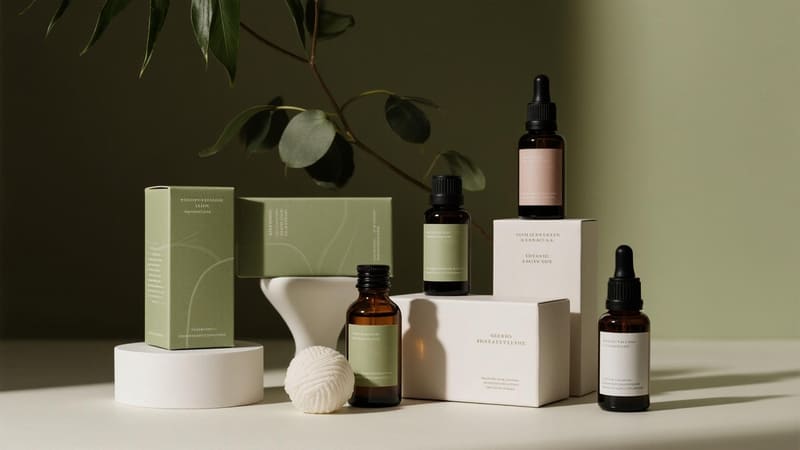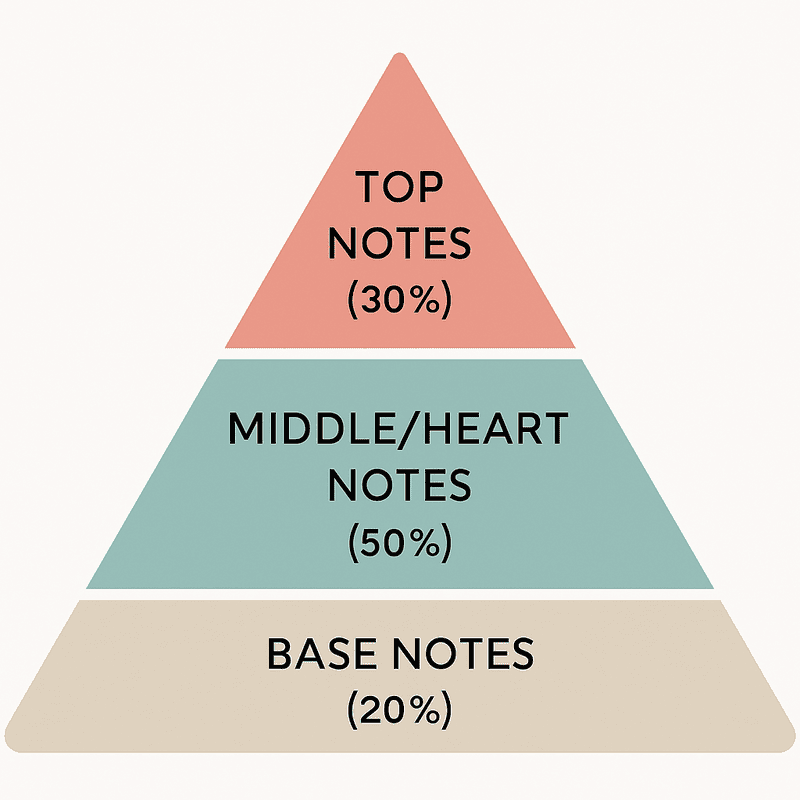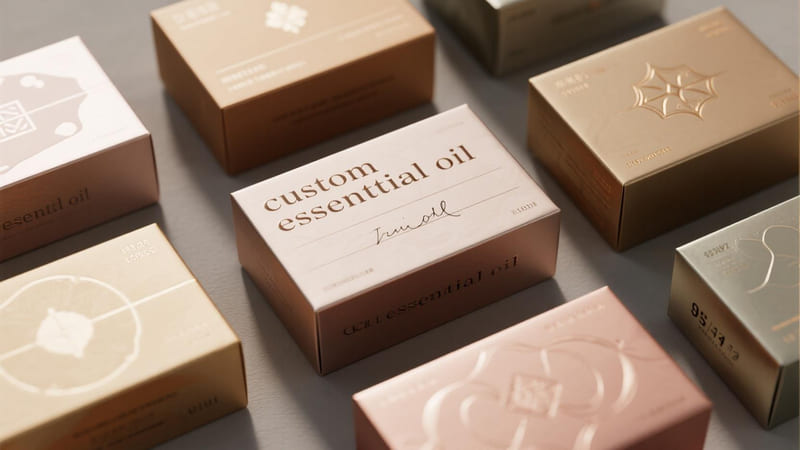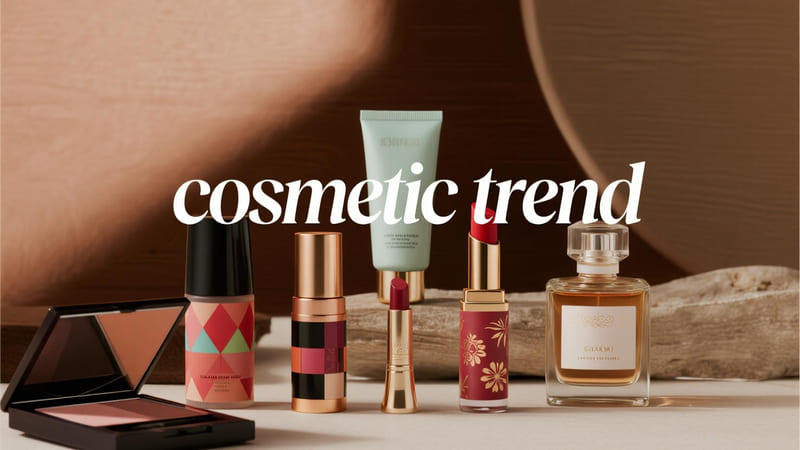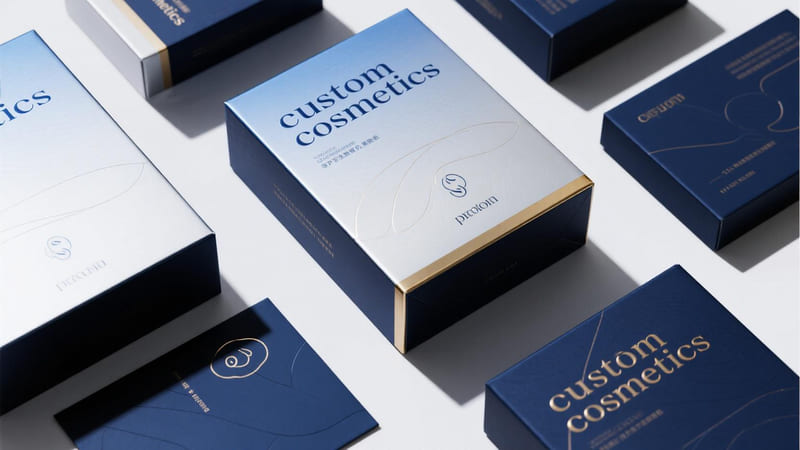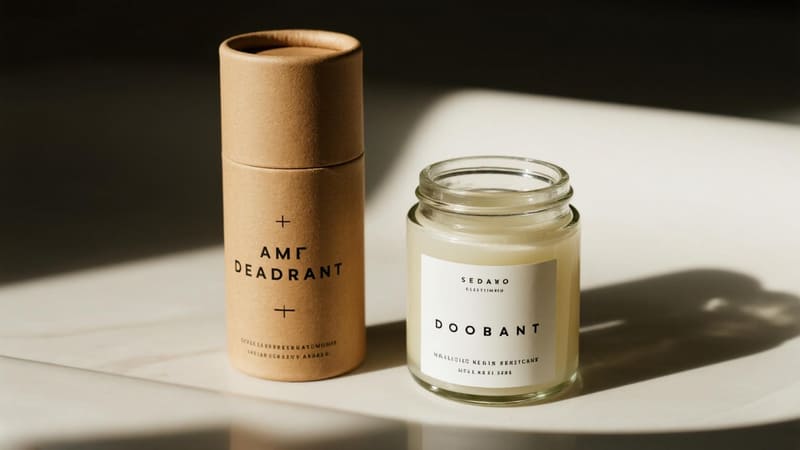Essential oils, with their potent natural essences, require packaging that is both protective and reflective of their pure, often therapeutic nature. Custom essential oil boxes elevate the product from a simple bottle to a complete, branded experience, offering endless possibilities for design and presentation.
Custom essential oil boxes are tailor-made secondary packaging solutions, typically crafted from paperboard or rigid board, designed to a brand’s specific requirements. Examples include minimalist folding cartons with botanical prints, luxury rigid boxes with custom inserts for gift sets, cylinder tube boxes for a unique shape, and eco-friendly Kraft paper boxes with die-cut windows.
A custom box does more than just hold the bottle; it tells the brand’s story, protects the precious oil, and creates a memorable first impression. As a packaging manufacturer with ShineTop, we specialize in creating these bespoke solutions, turning a brand’s vision into a tangible, high-quality box. Let’s explore some popular custom styles.
What is the Best Packaging for Essential Oils?
The "best" packaging for essential oils is a two-part system: a protective primary container and an informative, brand-aligned secondary box. Both are crucial for maintaining the oil’s quality and market appeal.
The best primary packaging for essential oils is a dark-colored glass bottle (amber, cobalt blue) to protect against UV light, with a secure cap and orifice reducer or dropper. The best secondary packaging is a sturdy, custom-fit paperboard or rigid box that provides physical protection, an additional light barrier, and ample space for branding and regulatory information.
This combination ensures the oil is preserved from environmental damage while being beautifully presented.
The Ideal Packaging System:
-
Primary Container (The Bottle):
- Material: Glass is essential because it’s inert and won’t react with the potent essential oils.
- Color: Dark glass (amber is the most common) is non-negotiable for protecting the oil from light degradation, which can alter its chemical composition and therapeutic properties.
- Closure: A well-fitting cap to prevent oxidation, often with a tamper-evident seal. An orifice reducer for controlled dropping or a glass dropper for easy application are standard.
-
Secondary Packaging (The Custom Box):
- Protection: The box provides crucial cushioning against bumps and breakage for the glass bottle during shipping and on retail shelves.
- Light Barrier: It offers a complete, final barrier against light exposure.
- Branding: The box is the main canvas for your brand’s logo, color scheme, and aesthetic (e.g., minimalist, botanical, clinical, luxurious).
- Information: It provides the necessary space for all required information: oil name, botanical name, volume, usage instructions, safety warnings, batch number, etc.
- Perceived Value: A high-quality, well-designed box significantly enhances the perceived value of the essential oil.
What is the 30 50 20 Rule for Essential Oils?
This rule is fundamental to the art of blending essential oils, which is often what goes into the bottles that need packaging. Understanding it provides insight into the product itself.
The 30-50-20 rule is a classic blending guideline for creating a balanced and harmonious essential oil aroma. It suggests a ratio of approximately 30% top notes (light, fast-evaporating), 50% middle notes (the "heart" of the blend), and 20% base notes (deep, long-lasting fixatives).
This structure creates a scent that evolves pleasantly over time.
- Top Notes (30%): The initial, bright impression. Examples: Lemon, Bergamot, Peppermint.
- Middle Notes (50%): The core character of the blend. Examples: Lavender, Geranium, Rosemary, Chamomile.
- Base Notes (20%): The deep, grounding foundation that makes the scent last. Examples: Sandalwood, Cedarwood, Frankincense, Vetiver.
How it Relates to Custom Boxes: The character of the blend can inspire the box design. A bright, citrus-heavy blend might use vibrant, light-colored packaging. A deep, woody, resinous blend might be housed in a box with darker, earthier tones and more substantial, tactile materials. The box design can visually communicate the scent profile within.
What are Custom Packaging Boxes?
Custom packaging boxes are not off-the-shelf solutions; they are designed and manufactured from the ground up to meet a brand’s specific needs.
Custom packaging boxes are containers made to a brand’s unique specifications in terms of size, shape, material, color, printing, and finishing techniques. Unlike stock boxes, they are tailor-made to perfectly fit the product, embody the brand’s identity, and create a distinctive unboxing experience.
Key Elements of Customization (What You Can Specify):
- Dimensions: Tailored to the exact size of your essential oil bottle(s) for a snug, protective fit.
- Material:
- Paperboard Type: SBS for clean printing, Kraft for a natural look, recycled board for sustainability.
- Rigid Board: For luxury gift sets or premium single bottles.
- Structural Style:
- Standard folding cartons (e.g., Reverse Tuck End).
- Luxury styles like drawer boxes, hinged lid boxes, or cylinder tubes.
- Printing:
- Custom graphics, patterns, logos.
- Specific Pantone (PMS) colors to match your brand guide.
- Finishes:
- Lamination (Matte, Gloss, Soft-Touch).
- Foil Stamping (Gold, Silver, Copper, Holographic, etc.).
- Embossing or Debossing for tactile texture.
- Spot UV for contrasting gloss effects.
- Inserts: Custom-designed inserts (paperboard, molded pulp) to hold single or multiple bottles securely.
At ShineTop, creating custom packaging boxes is our specialty. We work with brands to bring their unique vision to life, from the initial design concept to the final, beautifully finished box.
What is the Highest Quality Brand of Essential Oils?
Identifying the single "highest quality" brand of essential oils is challenging and often subjective, as quality can be defined by purity, sourcing ethics, therapeutic profile, and brand transparency. There is no official governing body that ranks brands.
While there’s no official #1, brands widely recognized by aromatherapists and discerning consumers for their commitment to high quality, purity, and transparency include Plant Therapy, doTERRA, Young Living, Edens Garden, and Rocky Mountain Oils. Key indicators of quality are third-party testing (GC/MS reports), transparent sourcing information, and a focus on pure, unadulterated oils.
"Highest quality" is less about a brand name and more about a brand’s practices.
What to Look for in a High-Quality Essential Oil Brand:
- Third-Party Testing (GC/MS Reports): This is crucial. Gas Chromatography/Mass Spectrometry (GC/MS) testing analyzes the chemical constituents of the oil, verifying its purity and ensuring it hasn’t been adulterated. Reputable brands make these test results available to consumers for each batch.
- Transparent Sourcing: The brand should provide information about the botanical name of the plant, the country of origin, and the extraction method.
- Purity: The brand should guarantee their oils are 100% pure, free from fillers, additives, or synthetic fragrances.
- Proper Packaging: Selling oils in dark glass bottles (amber, cobalt blue) is a non-negotiable sign of a quality brand that understands how to protect its products.
- Reputation & Education: Brands that focus on educating consumers about safe and effective use, rather than just making bold marketing claims, are often more trustworthy.
- doTERRA & Young Living: These are large Multi-Level Marketing (MLM) companies known for their extensive range and strong quality control, though their business model and pricing are debated.
- Plant Therapy, Edens Garden, Rocky Mountain Oils: These are popular non-MLM brands that are highly regarded for their quality, affordability, and commitment to providing third-party testing reports.
How This Relates to Custom Boxes:
A brand that invests in this level of product quality will want its packaging to match. Their custom essential oil boxes will likely be designed to reflect this commitment to purity and efficacy. For example, they might choose eco-friendly materials like recycled Kraft paperboard (like my client Anna from Thailand would) or a very clean, clinical design with minimalist typography and perhaps a touch of elegant foil to signify quality.
Examples of Custom Essential Oil Box Styles:
-
The Natural & Artisanal Box:
- Material: Uncoated or matte-finished Kraft or recycled paperboard.
- Design: Features botanical illustrations, earthy color palettes, and simple typography.
- Finishes: Maybe a simple blind emboss or a single-color print with soy-based ink.
-
The Clinical & Therapeutic Box:
- Material: Clean, white SBS (Solid Bleached Sulfate) paperboard.
- Design: Minimalist, precise layout. Focus on clear information: botanical name, key constituents, benefits. Often uses a sans-serif font.
- Finishes: A clean matte varnish, perhaps with a subtle spot UV on the logo.
-
The Luxury & Gift Box:
- Material: Rigid board construction with a specialty paper wrap (e.g., soft-touch or textured).
- Design: Can be a hinged lid box with a magnetic closure or a drawer box. Often designed for sets of multiple oils.
- Features: Custom-fit insert (EVA foam, molded pulp) to hold bottles securely.
- Finishes: Gold or silver foil stamping, elegant embossing, ribbon pulls. My client Mohammed from Iraq would choose this style for a high-end aromatherapy gift set.
-
The Modern & Vibrant Box:
- Material: SBS paperboard for bright color reproduction.
- Design: Uses bold colors, geometric patterns, or modern graphics to appeal to a younger demographic.
- Finishes: Gloss lamination to make colors pop, or creative die-cut windows.
Conclusion
Custom essential oil boxes are a vital tool for any brand looking to succeed in this competitive market. By moving beyond generic packaging, brands can create a presentation that protects the precious oil, communicates a unique identity—be it natural, clinical, or luxurious—and enhances the overall customer experience. The best packaging system combines protective dark glass bottles with a custom-designed box that is thoughtfully crafted in its material, structure, and design, reflecting the quality and character of the essential oils within.

